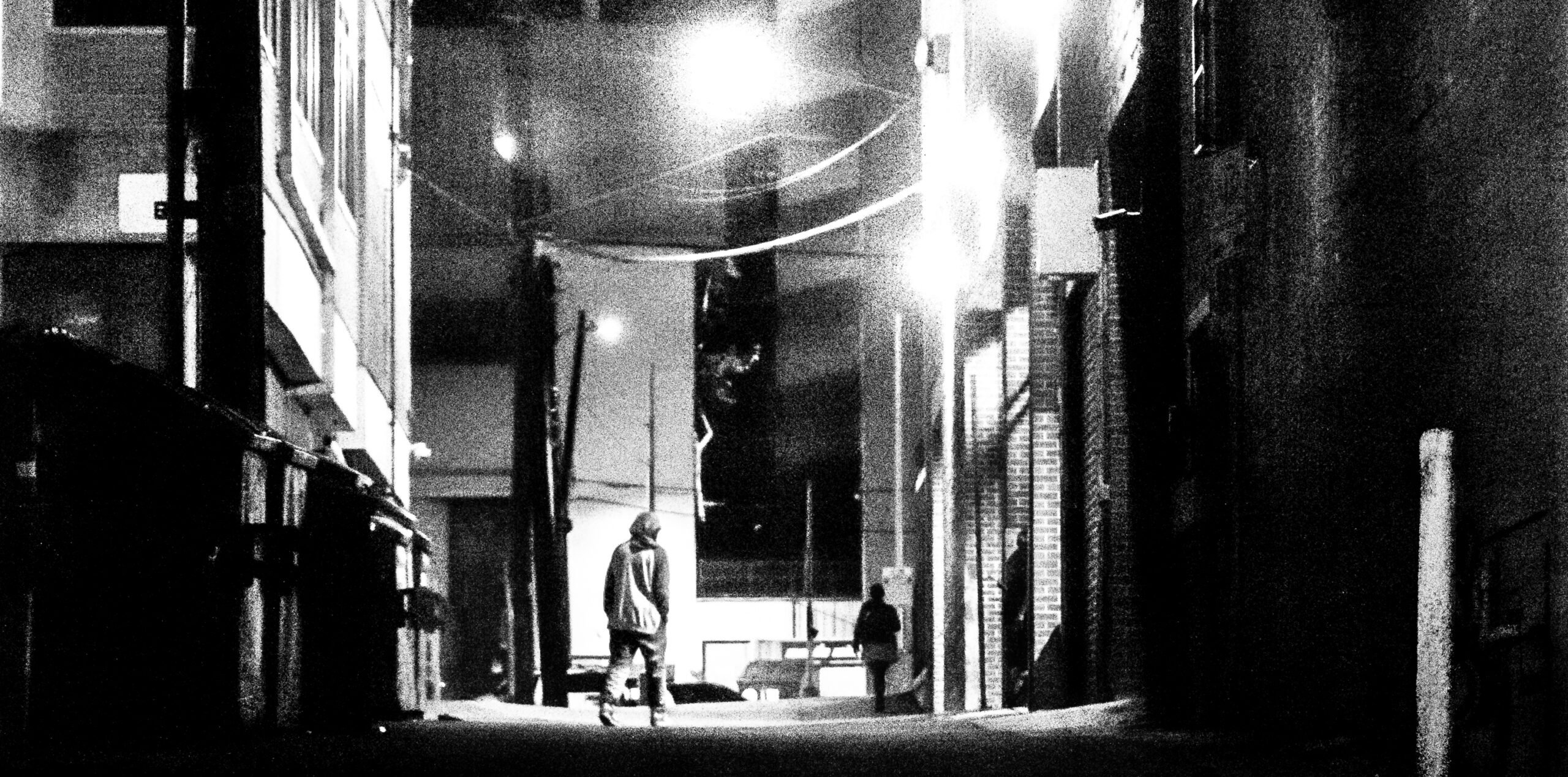Ink-Stained Kvetches
Where are all the editorial cartoonists going?

So these three editorial cartoonists walk into a bar …
Wait, hold on, let’s back this joke up. First of all, there’s no bar. The editorial cartoonists in question are on the Waco campus of Baylor University, and despite the easily traipsable 1,000-foot walk to the nearest watering hole, that’s hardly why they’re here.
Second, speaking strictly, there’s really only one man of this trio drawing a paycheck as an editorial cartoonist. That’s Ben Sargent, the Pulitzer Prize-winning icon from the Austin American-Statesman. The other two—Bill DeOre and Dan Foote, formerly of the Dallas Morning News and the long-defunct Dallas Times Herald, respectively—are treading the waters of the freelance-illustration world, and have been for quite some time.
And third, well, a joke is probably the wrong place to start. For one thing, editorial cartoons are not necessarily laughing matters, addressing as they can the most maudlin of obituary sentiments and the most brazen of political hypocrisies.
For another, the profession of editorial cartooning itself, appended to the health of the American newspaper, is on life-support.
But never mind all that for now.
These three editorial cartoonists are walking around campus, following Baylor journalism professor Robert Darden, himself a one-time practitioner of their dying art and the co-curator-instigator of “Drawing Power,” a campus-wide exhibition of editorial cartoons, on display through December 20.
From library to library they walk: Moody, Jones, Poage, each displaying a portion of the exhibit’s 100-plus cartoons by 18 mostly Texas cartoonists, many drawn from Darden’s private collection. (Darden’s University of North Texas master’s thesis, on Dallas Morning News cartoonists John Knott, Herc Ficklin, and Bill McClanahan, was published in book form under the title Drawing Power in 1983.)
Along the way, they traverse a historical trajectory of their art form.
There’s John Knott (1878-1963), an immigrant from Austria who joined the Dallas Morning News staff in 1905 and created his enduring “Old Man Texas” character—the state’s earthy counterpart to Uncle Sam—in 1906.

There’s Jack Hamm (1916-1996), a favorite son of Baylor whose inspirational artwork and “picture sermons,” syndicated under the banner of “Religious Drawings,” at one point reached as many as 29 million weekly readers.
There are Herc Ficklin (1911-1980) and Bill McClanahan (1907-1982), the dueling draftsmen who alternated editorial cartoons and political positions (Ficklin was the liberal, McClanahan the conservative) at the Morning News during the postwar period. (Bill DeOre found himself the victim of a “reduction in force” in 2004, 35 years after succeeding them. There’s probably no better example of the decline of editorial cartooning than the Morning News, from two cartoonists to one to the current none.)
There’s Bob Dale, who retired from the San Antonio Express-News in 1985; and Sam Nash (1906-2000), who spent his career at the Tyler Courier-Times; and Jim Palmer, who shared cartooning duties with DeOre at the Morning News in the 1970s; and Clyde Peterson, aka CP Houston, who retired from the Houston Chronicle in 2006; and Bob Taylor, hired as the Dallas Times Herald‘s first editorial cartoonist in 1958; and Dan Foote, who took over at the Times Herald in 1989, just two years before the paper folded.
And there’s Ben Humeniuk, a 2008 Baylor grad whose college cartooning for The Lariat has earned several awards, and who can’t be thrilled about his professional prospects. There are no more two-cartoonist papers in Texas, just as there are no more two-daily newspaper towns in Texas. There is no more staff cartoonist at the Tyler paper or any other small or midsized Texas daily. Etta Hulme recently ceased working full-time for the Fort Worth Star-Telegram.
It’s an illuminating show, filled with oddities like the weirdly innocuous panel Herc Ficklin published the day of John F. Kennedy’s fateful 1963 arrival in Dallas (JFK stands in the back of a Lyndon Johnson-driven jeep, rifle in hand, taking aim at a deer labeled “Texas electoral votes”), and one of Jack Hamm’s many personal Bibles, highlighted and annotated in the artist’s own hand, the margins crammed with commentary.
Despite the optimistic inclusion of Humeniuk, “Drawing Power” is a bit of a bummer. Aside from the venerable Ben Sargent, whose paper, the American-Statesman, recently was put unceremoniously up for sale, not a name in the bunch is currently working in the field.
Sargent, 59, with his anachronistic three-piece suits and watch fobs and Ben Franklin bifocals, might as well be the poster boy for the last of his breed. He is in fact one of only three full-time editorial cartoonists working for daily newspapers in Texas.
Foote and DeOre miss it. You can tell. They’re flattered, certainly, to see their work enshrined, but the implicit museumification of their art carries an unmistakable subtext of sadness, though each does his best to laugh—or at least crack wise—through the painfully obvious. There’s no getting around it, though: What should be a celebration is also an odd and not terribly funny sort of wake.
What did Bob Darden take away from the afternoon in the company of his heroes?
“To be honest,” he says, “I was a little more convinced of what I’d already felt building the past few years, that the people who run most newspapers don’t have a clue, and that the very distinctive elements that make newspapers a necessity with people are the things that these corporate owners seem to be most eager to do away with.”
How did it come to this?
Money, mostly. Editorial cartoonists are specialized journalists, and journalists are employed by newspapers. Now that Craigslist has stolen their classified ads and the Internet is stealing their eyeballs and bloggers are stealing their work and publishers are merging their properties under the banners of publicly held corporations, newspapers are in an absolute tizzy about how to maintain 30-percent profit margins and pump up the value of their stocks. Their response, in many cases, has been to slash and burn staff, and that means editorial cartoonists—just like investigative reporters and film critics and book review editors—are taking the hits.
If you hang around editorial cartoonists long enough, you will hear certain numbers repeated. For instance: In the post-Nixonian 1970s, the last acknowledged Golden Era of political cartooning, when floods of imitators and acolytes followed Australian immigrant Pat Oliphant into the newly satirical field, U.S. newspapers employed as many as 250 editorial and political cartoonists. Today, though there is no census, that number is widely understood to have dipped below 90.
A 2004 report on editorial cartoons from Harvard’s Nieman Foundation for Journalism leads off with stories titled “Are We Witnessing the Dusk of a Cartooning Era?” and “The Evaporating Editorial Cartoonist.”
In 2000, when cartooning eminence Jeff MacNelly died, the Chicago Tribune decided not to replace him. In 2004, the Los Angles Times laid off Pulitzer-winning cartoonist Michael Ramirez, who hasn’t been replaced. That same year, veteran cartoonist Kevin “KAL” Kallaugher took a buyout and left the Baltimore Sun. He has not been replaced. In 2005, the Durham (North Carolina) Herald-Sun fired full-time cartoonist John Cole. Not replaced. In 2006, the Pittsburgh Post-Gazette cut 30-year veteran cartoonist Tim Menees’ job, and Illinois’ Northwest Herald laid off award-winner Scott Nychay, but kept running ads bragging on him into 2007.

More recently, Milwaukee Journal Sentinel cartoonist Stuart Carlson took a buyout this year in what the blog Milwaukee.com called a “voluntary mandatory staff reduction.” The Cincinnati Enquirer‘s Pulitzer winner Jim Borgman took a buyout after 32 years at the drafting table. Framingham, Massachusetts’ MetroWest Daily News laid off 31-year veteran cartoonist Dave Granlund in a cost-cutting measure. The Raleigh News & Observer decided to cut cartoonist Dwane Powell back to part time and eliminate his benefits. When Powell decided he’d rather resign, the paper agreed to keep him on through the November elections, after which he’ll be shown the door. None of those papers has announced plans to replace its outgoing cartoonist.
Closer to home, Hulme—the longtime Fort Worth Star-Telegram cartoonist and one of the few women in the business—retired from full-time work this year, not to be replaced. When editorial cartoonist Pat McCarthy of the Amarillo Globe-News and Amarillo Globe-Times died in August, his paper left his position dark.
It’s bleak out there for cartoonists. It’s bleak for newspapers, too, and they’re cutting corners wherever they can, not just on the editorial pages. Industrywide, hundreds of reporters have taken voluntary buyouts in recent years, and hundreds more have been laid off.
An editorial cartoonist might draw four or five cartoons a week and might earn $50,000 to $70,000 a year. A popular cartoonist with a good syndication list might make another $20,000 annually on top of that. It’s a decent enough living, but hardly extravagant with a kid or two in college.
Take away the main gig, as happened to Dan Foote, and it’s icing without the cake. For five years after the Dallas Times Herald went under, Foote soldiered on in syndicate before giving up and turning to corporate illustration work and Christian children’s books to pay the bills. Losing the job was “like having a spouse die,” he says, and everyone laughs at the melodrama.
“It’s tough when you dedicate your whole life, 34 years, you want to keep going,” DeOre says. “Especially an election year like this.”
Tough, but probably inevitable. The entire business model of newspapers is changing.
“Just look around this room,” Foote says, sweeping the library with his hand. You can check out laptops at the front desk. Not a student in sight is reading anything paper-based.
The cartoon business is the same. For $50, a newspaper editor can buy a syndicated cartoon (that’s what the Observer does). It won’t be local, but then again it probably won’t offend local advertisers, either. Readers, for their part, can go to www.cagle.com and spend all day looking at syndicated editorial cartoons for free. Why pay to see one a day in the paper? In fact, why pay for a paper at all when the paper is posted online for free?
On the other hand, as Sargent points out, it’s almost impossible to make a living as a purely syndicated cartoonist, and “when those newspapers get rid of all those cartoonists, then the syndicated cartoonists aren’t there.” At the same time, the market for syndicated cartoons is shrinking as more newspapers merge and go under.
It’s like a bad joke: Which will die first, the newspaper or the editorial cartoon?
Cheer up—editorial cartooning isn’t dead yet. It may even be that the form is simply going through a technology-driven transition, as editorial cartoons have done before (nobody’s etching the things on metal plates anymore), and as art forms always do. Remember vaudeville? Foote points out that vaudeville didn’t just die. It morphed into radio and television, and its most adaptive performers morphed with it, inserting the DNA of the dying beast into the new medium.
And not every Texas newspaper has given up entirely on the editorial cartoon.
There’s still John Branch at the San Antonio Express-News. He grew up in Chapel Hill, North Carolina, went to school there, and then went to work for the local paper under the eagle eye of the same editor who had earlier hired Jeff MacNelly. The Express-News hired him in 1981—in what was then a two-newspaper, two-editorial-cartoonist town—and he’s been there ever since.
Yes, Branch admits, the state of the industry is kind of screwed at the moment—”We’re somewhere in the big in-between right now,” he says. But as to the state of the actual art, “I think it’s pretty good, and I think a lot of it has to do with some of the younger, more alternative-type cartoonists.
“I think Ted Rall does some really powerful stuff,” he says. “I like Matt Bors a lot. Tom Tomorrow”—all cartoonists who market themselves primarily to alternative newsweeklies.
“There’s a lot of fresh new stuff out there,” Branch says. “I don’t know if it’s a golden age or not, but contrary to the economics of it, I think the art and the wit and the opinions are as strong as ever. The economics just haven’t come into focus yet.”
There’s still Sargent, who won his Pulitzer with the American-Statesman in 1982 and shows no signs of slowing. If anyone does, he provides Foote’s vaudevillian linkage to newspapering’s past, having learned the printing trade in his hometown of Amarillo at age 12, back when there was still hot lead involved.
Perhaps most promising of all, there’s Nick Anderson, a 2005 Pulitzer winner from the Louisville Courier-Journal hired by the Houston Chronicle in February 2006. Of all the remaining Texas cartoonists, he’s the one most actively pushing the boundaries of the form’s online frontiers.
Still, as the outgoing president of the American Association of Editorial Cartoonists, he knows his business is on the ropes.
“It’s a real shame, and I think that newspapers are being extremely shortsighted when they cut their staff cartoonist, because it’s part of the personality of the newspaper,” Anderson says. “They think that they can get the same kind of content through syndication, but it really isn’t the same content. It doesn’t become part of the personality of the newspaper. And I think that people don’t necessarily keep coming back to see what the syndicated cartoons are.”
Anderson set out on his career path the old-fashioned way, as a kid who liked to draw. When he started reading newspapers and saw his first editorial cartoons, he says, “I was immediately taken with that concept of using a picture and a couple of words to express an opinion.”
He studied political science at Ohio State to put some weight behind his opinions and waltzed into his first job at the Courier-Journal right out of school—a trajectory he describes as “very, very fortunate.”
“The value of having a number of editorial cartoonists is having a number of voices adding to the marketplace of ideas,” he says. “These papers are trying like crazy to cut costs to try to stay ahead of the downward trends in the newspaper business, and they’re just kind of swinging the ax wildly. I don’t think they know what to do, and I think they’re kind of in panic mode, or even suicide mode.”
If newspapers aren’t willing to invest in their product and ride out some lean years, Anderson says, “I don’t know what hope there is.”
As president of the AAEC, Anderson was often called on as a spokesman for the argument that “every reader poll and analysis shows that readers respond to visual content. And we’re talking about visual content that is locally produced, and that is about hard news, and that is also entertaining and engaging … I realize there’s a cost to it, but I think there’s a really good return on the investment in that you’ve got a person that adds personality to the paper and adds something that no one else really can.”

It’s an intuitively compelling argument, but there’s frustratingly little hard data to back it up.
The Poynter In
titute, a Florida-based nonprofit, recently polled newsp
per readers about their newspaper-reading habits. “We called them to find out what the response was for the editorial cartoonists, and they were embarrassed to tell us that they didn’t ask that,” Anderson says. “It’s a little frustrating.”
Lacking poll numbers, perhaps the best proof of the editorial cartoonist’s continuing worth, at least in Anderson’s case, is the very fact of the Chronicle‘s industry-bucking investment in him. Just as clearly, though, the paper expects more than just the same old daily panel in return. Anderson is working more often in color, which changes the rules of the game. He’s also blogging, posting drafts and sketches of abandoned ideas online. And he’s on the forefront of editorial cartooning’s tentative move toward animation.
“My workload has essentially doubled in the past five years,” Anderson says. Animation, especially, “is humbling. You know, I spent a lifetime learning how to distill an issue down to a single image and make it as simple as possible, and now I’m having to do the opposite, make things a little more complicated. It’s much more challenging than I expected.”
No matter where the technology leads, Anderson thinks there will always be a place for the good old-fashioned, single-panel editorial cartoon, the one pioneered by Ben Franklin and cemented in the national consciousness by Thomas Nast.
“You can pass a single cartoon around to your friends, and you can put it on your refrigerator,” he says. “That one little picture can say so much. And for that reason I don’t think it’s going to disappear. I don’t think it’s going to die. The nature of it is going to change. It may be deprofessionalized, which I think is a real shame, but people are still going to do this, and they’re still going to find a way to scratch out a living, and I’m confident that in 100 years, it’s going to exist, largely in the way it does now, with single images.”
Darden, wearing his historian’s hat, has to agree.
“Once we figure out the delivery system dilemma, we’ll see a rise again,” he says. “It’s just too special.”
Whether the newspaper of the future arrives on a cell phone or plastic sheet or a Kindle, Darden says, “people still have to know what’s going on.” And no matter the style, no matter the era, “those damn cartoons still make people mad and laugh at the same time.”


